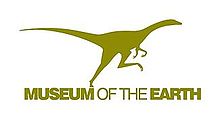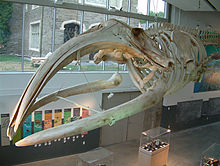- Museum of the Earth
-
 Entrance to the Museum of the Earth
Entrance to the Museum of the Earth
The Museum of the Earth is a public natural history museum. It is located in Ithaca, New York, on the campus of the PRI, its parent organization.
Contents
Paleontological Research Institution
PRI was founded in 1932 by Gilbert Harris, a professor of geology at Cornell University from 1894 to 1934. He founded PRI to house his collection of fossils and to publish research in paleontology - the study of the history of life on Earth. PRI began as a small building behind Dr. Harris' home in Ithaca, New York. Through various additions over the next two decades, the original building grew into a 20-room complex that housed the Institution's collections, library, laboratories, and offices.
PRI has continued to grow through the years, requiring a move to larger quarters in 1968. The present facility on West Hill, along Trumansburg Road (N.Y. Rte. 96), holds over 2 million fossils and shells, and a 50,000 volume research library. In 2003, PRI opened the 18,000-square-foot (1,700 m2) Museum of the Earth, a natural history museum that showcases PRI's specimens.
Exhibits
The Museum of the Earth showcases a wide selection of fossils from the collection of the Paleontological Research Institution, which contains over 2 million specimens, from microfossils to large Ice Age animals.
Permanent
North Atlantic Right Whale #2030
In the spring of 2004 a permanent exhibit on North Atlantic Right Whale #2030 opened in the Museum lobby, funded by a grant from the Nelson B. Delavan Foundation. The exhibit includes a short film by David Brown featuring footage of the unsuccessful attempts to rescue #2030 from the fishing gear that ultimately ended her life. Visitors are told how PRI and the Museum of the Earth aimed to create a memorial to the whale's life.
PRI’s North Atlantic Right Whale was mounted on a steel armature in a greenhouse on-site. The Museum building was left open on the northeast end so that the whale could be brought through for installation. In November 2002 a crane gently carried the pieces into the building and lifted them to the ceiling, where they were attached to a beam built into the roof specifically for the purpose of holding 8 tons of whale bones.[citation needed]
Rock of Ages Sands of Time
A 544-panel mural, each panel of which represents 1 million years, created by Ithaca artist Barbara Page. It seeks to give a new perspective on the emergence of life on earth. The panels represent an unbroken sequence of twelve geological periods that span an eon.
A Journey Through Time
This exhibit leads visitors through the eons from the Big Bang to the present day, aiming to challenge their perceptions about the present, future, and human effects and dependence on Earth.
- The Cambrian, Ordovician, and Silurian Periods - visitors can watch the formation of the solar system and planet Earth, and learn how the Cambrian Explosion started life in the seas.
- Fossil Preparation Lab - visitors can interact with Museum staff as they prepare specimens for exhibition and research.
- Beneath an Ancient Sea - an exihibit about the warm, shallow seas which covered central New York 380 million years ago. It includes a model of the 30-foot (9.1 m) carnivorous Dunkleosteus from the Devonian period. Visitors can explore the process of plate tectonics that built the Appalachian Mountains and the rapid biological evolution that was taking place at this time.
- Carboniferous, Permian, and Triassic Periods
- Where Dinosaurs Walked - visitors can learn how ideas and depictions of dinosaurs changed with scientific discoveries, and how an animal adapts to its environment with games relating to and examples of natural selection.
- Jurassic, Cretaceous, and Tertiary Periods - visitors learn about the dominance and demise of dinosaurs through specimens, film, and images. The exhibit also teaches about the origin of birds and flowers and the mass extinction that killed the dinosaurs.
- A World Carved by Ice - visitors can explore how changes in climate affect life, and how glaciers formed the landscape of the Finger Lakes.
- Biodiversity and Extinction - this exhibits aims to make visitors reflect on how humans fit into the complex network of life on Earth and how the history of the Earth is an integral part of human life. Visitors are also shown the effects of both human and natural factors on extinct and endangered animals.
- The Gorge Garden - a garden that recreates the northeastern United States during the Ice Age, with tundra vegetation, polished gravel, and large boulders (glacial erratics). This exhibit was funded by a grant from the Ithaca Garden Club.
Hyde Park Mastodon
This exhibit tells the story of this accidental find and how it was brought into the Museum. In late 2002/early 2003 the skeleton of the Hyde Park Mastodon was cast by Jim Sherpa, working in the lab of mastodon paleontologist Dan Fisher at the University of Michigan. The bones were shipped in February 2003 to Prehistoric Animal Structures (PAST) of Calgary, Canada, where they built a non-invasive armature to mount the skeleton without damaging the bones. The armature and mastodon were then shipped to the Museum in summer 2003 for mounting.
Programs
Public Programs
Natural History at Noon On two Saturdays of every month, the Museum invites noted speakers to give short talks about their areas of expertise. The topics are varied and include lectures ranging from the history of the universe to fossils found in the rocks of New York State, to the relationships between art and natural history. Talks are held in the Ray Van Houtte Museum classroom.
The James Potorti Interpretive Walk series, offered four Fridays in the Summer, explores the spectacular geology of the local New York State Park gorges.
Architecture
Based on the internationally known natural history collections of PRI, the Museum of the Earth tells the story of the 4.6 billion year history of the Earth, focusing particularly on the Northeastern United States.
The Museum occupies an 18,000-square-foot (1,700 m2) addition to the present PRI complex on Ithaca's West Hill. The new building was designed by the New York architectural firm of Weiss/Manfredi, recently best known for designing the award-winning women's war memorial at Arlington National Cemetery. The design for the Museum has attracted much critical notice.
See also
Links
Categories:- Natural history museums in New York
- Museums in Tompkins County, New York
- Dinosaur museums in the United States
- Ithaca, New York
Wikimedia Foundation. 2010.




